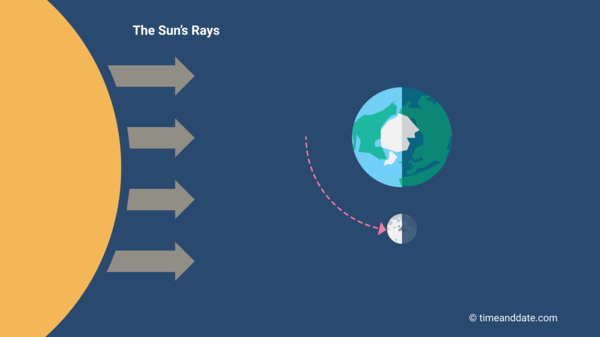The First Quarter Moon is a Half Moon
The First Quarter Moon is a primary Moon phase when half of the Moon's face is lit up. Whether it is the left or right half depends on where you are on Earth.

The First Quarter Moon rises around midday and is visible in the day sky.
©iStockphoto.com/JasonDoiy
April 2024: Jupiter and Moon close approach
Next First Quarter Moon
16 Apr 2024, 03:13
Previous First Quarter Moon
17 Mar 2024, 12:10
Times for the First Quarter Moon vary by time zone. Times and dates are based on the local time in Hong Kong. Change location
Half the Moon Is Lit Up
The First Quarter Moon is also called a Half Moon because the Sun's rays illuminate about 50% of the Moon's surface.
Half of the Moon’s surface is always illuminated by direct sunlight, except during lunar eclipses when Earth casts its shadow on the Moon. Just how much of that light we can see from Earth varies every day, and we call this a Moon phase.
Half Moon Visible During the Day
The Moon is the only astronomical object you can easily see in the day blue sky apart from the Sun. The First Quarter Moon rises around midday and sets around midnight. This is the opposite of a Third Quarter Moon, which rises in the middle of the night and sets in the middle of the day.
The Moon: Our natural satellite


The Golden Handle appears on the Moon's terminator a couple of days after First Quarter. You'll need a pair of binoculars, or the zoom function on your camera.
©iStockphoto.com/BrianEKushner & ©timeanddate.com
Soon after First Quarter, a Golden Sight
About two days after the First Quarter Moon, a delicate visual effect known as the Golden Handle or Jewelled Scimitar occurs. As sunlight creeps across the Moon's face, it lights up the peaks of the Montes Jura (a mountain range) above the still-dark Sinus Iridum (Bay of Rainbows), and a curved “handle” appears on the terminator, the line separating the dark and the lit-up side of the Moon.
Second Primary Moon Phase
In western culture, we divide the lunar month into four primary and four intermediate Moon phases.


The Moon's position at First Quarter Moon.
©timeanddate.com
First Quarter Moon is the second primary Moon phase when the Moon has reached the first quarter of its orbit around Earth, hence the name.
A Primary Phase Is an Exact Time
The first primary Moon phase is New Moon, while the third is the Full Moon, and the last is called Third Quarter Moon.
The primary Moon phases occur at a specific moment in time, and the intermediate Moon phases are the time between the primary phases. These are the Waxing Crescent Moon, the Waxing Gibbous Moon, the Waning Gibbous Moon, and the Waning Crescent Moon.
Same Phase Looks Different
Moon phases are the same all over the world. The same percentage and area of the Moon are illuminated no matter where on Earth you are. However, the Moon is rotated in different ways depending on the time, the date, your location, and the Moon's position in the sky. Therefore, the illuminated part can appear on the left, the right, the top, or the bottom.
Is the Moon upside-down in the other hemisphere?


It takes around 29.5 days to move through the eight Moon phases.
©timeanddate.com
Opposite Sides in Opposite Hemispheres
At the First Quarter in the Northern Hemisphere, the right half of the Moon is lit up, while the left half is illuminated in the Southern Hemisphere. Near the equator, the upper part is bright after moonrise, and the lower part is bright before moonset.
First Quarter Moon in Calendars
The symbol for First Quarter Moon in modern calendars is a circle split down the middle with the right side white and the left side black.
The other primary Moon phase symbols in calendars are: = New Moon,
= Full Moon,
= Third Quarter
The Moon illustration on our Moon phase pages indicates more accurately, although not perfectly, which part of the Moon is lit up.
Sleep, crime, and menstruation: how Moon phases affect humans
Affects the Tides
The ocean tides on Earth are mostly generated by the Moon’s gravitational pull. At the First and Third Quarter, the Moon and Sun pull in different directions, producing the smallest difference between high and low tide, known as neaps or neap tide.
The largest tidal range is around Full Moon and New Moon. During these Moon phases, the Moon and the Sun's gravitational forces combine to pull the ocean’s water in the same direction. These tides are known as spring tides or king tides.